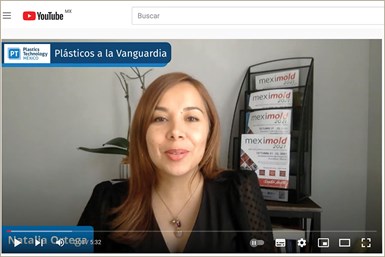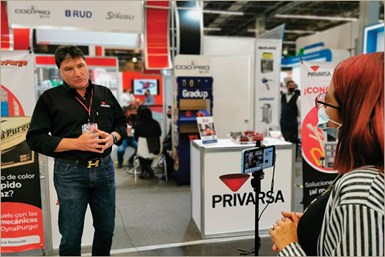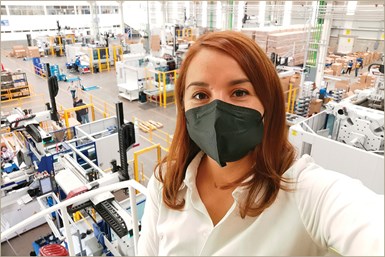When Talking About Manufacturing, It’s Time to Connect with Emotions
The last two years have been a roller coaster of emotions for almost everybody on this planet. In current times, feelings and moods are an essential part of the message to connect with audiences. Natalia Ortega, Editor in Chief for Plastics Technology Mexico, writes about why this is a valuable lesson from the pandemic when producing engaging content, even for industry.
#customerfocus
Employee Spotlight Profile
Maria Natalia Ortega, Editor in Chief, Plastics Technology Mexico

Since August 2020, we present a live video streaming on Fridays with the latest news from our weekly newsletter Plasticos a la vanguardia.
Over the last two years, Plastics Technology Mexico web platforms have seen unprecedented growth in statistics and interactions. Pageviews of the website grew 61%. Our followers in LinkedIn climbed more than 300%, and Facebook community expanded 84% with new followers. This is the result of hard editorial work, quality content, and team effort, but I believe it is strongly linked with how we have been able to connect with our audience in these challenging times. This is how we have been navigating brave waters with our readers during the pandemic and how we are working to understand their actual needs and information requirements.
It's All About Connection
In 2004, I entered the world of manufacturing publications after five years of writing about movies and pop culture for one of the first internet portals that were part of the digital boom of the late nineties. Although the main objective in my new industry role was creating content, I needed to understand the particular information requirements of plastics engineers at processing plants. In the beginning, I thought it was a very different world, but over time I have learned that they have more similarities than differences.
One of my dearest mentors in industrial media suggested a refreshing perspective to make that click with the audience: appeal to their curiosity and excitement. Discovering the latest technologies for injection molding, automation, digitalization, and more, for our readers, is much like when a little kid glimpses a toy catalog. That was an approach to start finding that sweet spot.
As I got to know the sector, I made that excitement my own. The amazement about an intricate, fully automated production cell, the possibilities of Industry 4.0 for a smart factory, or the infinite potential of plastics recycling in the circular economy became the core of my writing and the emotion I wanted to communicate. Instead of writing about why not to miss a movie, I found myself writing about why this or that machine was really innovative or looking forward to the latest release from recognized, trendsetter suppliers in the sector. So, I realized that in the end, content production is about how to connect with the audience and what they want, no matter the topic.
A Closer Voice
The bloom of social networks has given editors more creative freedom. A more relaxed voice emerged when reporting, by sharing content and news but sometimes, also, a reaction, a thought or an emotion. And that is the path I took at the start of the pandemic in March 2020. When interactions were limited to the screen, social networks became the window to observe the world. All news and articles from all types of media were related to COVID and there were a lot of feelings behind them: concern, caution, uncertainty and grief. So, even for a manufacturing media outlet, it was necessary to start looking at that juncture from a different perspective. Technology was still the center, but there were so many layers.
In the darkest days of the pandemic, the spark of hope and optimism was in the stories about how the plastics industry came to rescue, in record time, to provide all personal protection equipment, like face masks and shields. At Plastics Technology Mexico we participated in the initiative 'Dale un respiro México' (Give Mexico a breath), which gathered more than 18 companies who joined their production capacities to manufacture 500,000 face shields to be donated to medical staff in this country. It was touching to see the power of solidarity and cooperation.
Our participation started while preparing our May cover story about local manufacturing initiatives for COVID-19. Then, a plastic converter (one of our readers), who was leading the non-profit initiative, asked us if we could publish a piece of news or a post on social media to invite donors of PET sheet to join the project. They already had the mold, the manufacturing capacity and other materials but were requiring the sheet for the frontal part.
We posted the article, and the response was amazing: they received some PET sheet donations, and later the full story of 'Dale un respiro a México' was ranked among the most read and shared.
The mood was more optimistic at the end of 2020 and the start of 2021, and our headlines talked about projected growth, nearshoring and investments. As our contacts were still limited to just online, we made sure to keep the conversation active with a series of video interviews, delivering the latest news of the plastics industry in the weekly streaming 'Plasticos a la vanguardia' every Friday. Always highlighting opportunities!
Later, in the summer of 2021, everybody was eager for the comeback of in-person gatherings and encounters. For our industry, plant visits, conferences and trade shows are the essence of business, but also an important part of the fun. So, when we had the chance to make our first visit to a plant, it was quite an event. Back on the road in Mexico, our first story was a visit to an automotive components production plant for electric vehicles that is preparing to double its production capacity. It was a mixture of joy and excitement to set foot in a production factory again, to speak face to face with engineers to understand how they were using technologies and, above all, to be able tell such great news of investment and market growth.
One week before releasing the article, we published a post on LinkedIn with a selfie I took (machines in the background and a happy face, even with the face mask on), telling how excited I was to be back into action and how the feeling was like the first day of school. That post and, later, the full story, both made it to our top list last year!

When in-person events got the green light, we prepared our cameras, microphones and notebooks and went to the field. Angela Castro, Digital Editor, streaming live from a plastics show in Guadalajara.
A couple of months after that, when in-person events got the green light, we prepared our cameras, microphones and notebooks and went to the field. We were at Amerimold in Illinois, at Fakuma in Germany, at Meximold in Queretaro and finally Expo Plasticos in Guadalajara. Each reunion with colleagues, friends and clients was a shot of energy. Even through the masks, bright eyes were a sign of confidence and hope that there were good things yet to come.
While talking to people at those shows, it was so rewarding to find out the impact of the last two years' videos, posts, and publications. One person told me: “What you published about the donation of face masks from plastic companies was incredible. It allowed us to show people how plastics were helping during the pandemic.” Another person mentioned that during some hard months in sales, just watching the weekly video streaming gave him strength to be patient and wait for the better times that came a bit later. There was other case where a client of the magazine told me our first plant visit happened to be the same week that he made his first visit, too. As he recalled, it was so moving for him to find out that somebody else had the same feeling of happiness and appreciation for the opportunity to recover something that was lost for a while.

Selfie during our first plant visit in Mexico after almost 18 months: machines in the background and a happy face, even with the face mask on.
It was a revelation for us to discover that connecting with the community's feelings and moods was vital for the engagement we have seen in our reports. Listening to our audience's deep concerns, interests and desires, and responding accordingly, is the basis for building a long-lasting bond. B2B communications strategies are mainly oriented to deliver messages from brand to brand and from company to company. However, the pandemic opened up a cocoon and let us show more of ourselves, and we cannot let that pass.
Need more information?
Natalia Ortega, Editor in Chief
Plastics Technology México
LinkedIn
About the Author
Maria Natalia Ortega
Maria Natalia Ortega joined Gardner Business Media in 2015 as Editor in Chief of Plastics Technology Mexico and was part of the team that developed and launched the publication, aimed to an audience of +15,500 influential Mexican plastics processing professionals, in all its platforms: print magazine (9 issues per year), web portal and digital e-newsletters.
Natalia accumulates more than 20 years of experience in editorial roles for digital media and publications related with manufacturing. She is Journalist with a Master´s degree in International Affairs at Universidad Externado de Colombia. In 2014 she was a Knight Wallace Fellow at the University of Michigan and a Siemens Environmental Journalism Award recipient in 2011.
She is particularly active in contributing to the conversation about plastics, recycling, sustainability and Circular Economy, and enjoys using social media and digital platforms as a key resource for storytelling.
RELATED CONTENT
-
How to Write a B2B Marketing Email That Works
B2B copywriter David McGuire shares four tips to help stand out in a crowded inbox. He tries to stick to these four key principles when writing emails.
-
Understanding Brand Affinity
An approach that seems to help understand customer behavior regarding brand loyalty and insistence is the work done by experts who look at customer brand involvement as a combination of involvement and emotional content. An understanding of customer behavior finds that insistence for brands will vary based on either the brand's personality or the brand's reflection of the buyer's personality. There is an important distinction between identification with a brand and a belief that the brand identifies with you.
-
Brand Insistence Vs. Brand Loyalty
While it may be difficult to determine if you have achieved true, valuable brand loyalty, it is not impossible. Here’s a look at an important issue in terms of achieving true brand value.


